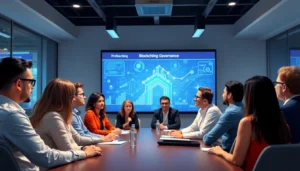Table of Contents
ToggleIn a world overflowing with information, finding clarity can feel like searching for a needle in a haystack. Enter mind mapping sessions—the superhero of brainstorming that swoops in to rescue creativity from the clutches of chaos. With a splash of color and a sprinkle of imagination, these sessions transform ideas into visual masterpieces that even Picasso would envy.
Overview of Mind Mapping Sessions
Mind mapping sessions serve as an effective strategy for organizing thoughts and generating ideas. Participants utilize visual diagrams to represent concepts and their relationships. This approach enhances clarity and creativity by breaking down complex information into manageable segments.
During these sessions, individuals create a central idea that branches out into related topics or subtopics. Each branch can further subdivide, allowing for detailed exploration. This structure helps in identifying connections between different ideas, leading to more insightful outcomes.
Tools for mind mapping include digital software and traditional pen-and-paper methods. Digital resources often provide templates and collaboration features, increasing group engagement. Pen-and-paper techniques allow for spontaneous creativity, fostering a relaxed atmosphere.
Benefits of mind mapping sessions include improved memory retention and deeper understanding. Studies show that visual representations significantly enhance cognitive processing. Participants often report higher motivation levels during these sessions, making the brainstorming process more enjoyable.
Groups may hold these sessions in various settings, from classrooms to corporate meetings. Flexibility in setup caters to different needs and preferences. Capturing diverse perspectives during a mind mapping session encourages collaboration and innovation.
Ultimately, implementing mind mapping sessions can transform the way teams approach problem-solving and idea generation. By focusing on visual organization, participants find greater clarity and inspiration in their work.
Benefits of Mind Mapping Sessions

Mind mapping sessions offer numerous advantages that enhance the creative and organizational aspects of brainstorming. These benefits create a dynamic environment for idea generation and collaboration.
Enhanced Creativity
Mind mapping stimulates creative thinking. Participants explore multiple concepts simultaneously which leads to a rich flow of ideas. By visualizing connections, they unlock new perspectives on problems. Various mind mapping techniques encourage divergent thinking, allowing individuals to break free from conventional thought patterns. This approach inspires innovative solutions that might otherwise remain hidden in traditional brainstorming methods. Visual representation of ideas enhances engagement, making sessions not only productive but enjoyable.
Improved Organization
Mind mapping enhances organization significantly. Central ideas serve as anchors, with branches indicating related topics and subtopics. This hierarchical structure clarifies complex information by breaking it into digestible segments. It allows participants to visualize relationships between ideas effectively. The layout promotes logical flow, making it easier to identify gaps in knowledge or areas that need further exploration. Both digital tools and paper formats support this organization, catering to diverse preferences. Improved organization leads to efficient discussions and actionable outcomes during brainstorming sessions.
Key Techniques for Effective Mind Mapping
Effective mind mapping sessions rely on specific techniques that enhance creativity and organization. Utilizing the appropriate tools and structuring maps properly can lead to a productive brainstorming experience.
Selecting the Right Tools
Choosing the right tools can significantly impact the effectiveness of mind mapping sessions. Digital software like MindMeister, XMind, and Lucidchart offers features for collaborative brainstorming and easy editing. Traditional pen and paper methods provide tactile engagement, creating a personal touch that some participants may prefer. Each option encourages exploration in its own unique way. Assessing team preferences and the session goals guides the selection process, ensuring maximum participation and innovation. Experimenting with various tools may reveal what works best for a specific group or project.
Structuring Your Mind Map
Structuring a mind map effectively allows for better comprehension of complex ideas. Starting with a central theme creates a clear focus point. Branching out into subtopics promotes deeper exploration of related concepts. Using colors and images can make connections clearer while enhancing visual appeal. Organizing information hierarchically helps identify priority areas and reduces information overload. Regularly revisiting and adjusting the structure ensures clarity and coherence throughout the session. Inviting contributions from all participants enriches discussions and leads to a comprehensive understanding of the subject matter.
Best Practices for Conducting Mind Mapping Sessions
Prioritizing a clear central idea sets the foundation for effective mind mapping sessions. Start by brainstorming a concise central theme that resonates with all participants. Branch out into key topics and subtopics, ensuring each is relevant and distinct. Participants should feel encouraged to explore multiple ideas simultaneously, fostering a stimulating environment.
Using digital tools like MindMeister or XMind enhances collaboration and organization. Traditional pen-and-paper methods might also offer a personalized touch crucial for creativity. Choosing the right medium serves as a catalyst for engagement, allowing for a seamless flow of ideas.
Incorporating visual elements is essential for enhancing understanding. Utilize colors, images, and symbols to boost memory retention and make information more digestible. Engaging all members in the discussion fosters a sense of ownership and drives deeper connections between ideas.
Setting a time limit can sharpen focus and maintain momentum. Deadlines promote efficiency, encouraging participants to concentrate on generating innovative solutions. That structured approach transforms complex discussions into actionable insights.
Regularly reviewing and revising the mind map encourages continuous improvement. Participants benefit from reflecting on previous sessions and adjusting strategies as necessary, leading to richer discussions in future meetings. This iterative process cultivates ongoing collaboration and creativity.
Incorporating flexibility within sessions accommodates different thinking styles and needs. Recognizing individual preferences enhances the overall experience, ensuring diverse perspectives contribute to the mind map. A well-rounded representation ultimately leads to more thorough exploration and innovative outcomes.
Real-Life Applications of Mind Mapping Sessions
Mind mapping sessions find practical use across various fields such as education, business, and project management. In classrooms, teachers utilize mind maps to enhance student engagement during lessons. They support collaborative learning by allowing students to visually organize their thoughts and explore subjects more interactively.
Businesses employ mind mapping to facilitate strategic planning and team brainstorming. Project managers benefit from visual layouts to define project tasks and timelines clearly. This method streamlines communication and ensures that all team members understand their roles and responsibilities.
Healthcare professionals use mind mapping for patient care planning. They effectively outline treatment processes and track patient progress while promoting a patient-centered approach. Mind maps allow healthcare teams to visually connect symptoms, diagnoses, and treatment options, enhancing collaborative decision-making.
Non-profit organizations implement mind mapping during fundraising and outreach initiatives. Visualizing strategies and stakeholder relationships fosters a comprehensive understanding of their mission and goals. This clarity leads to improved engagement with volunteers and donors.
Moreover, workshops and training sessions often incorporate mind mapping. Facilitators encourage participants to brainstorm ideas collectively, leading to innovative solutions and knowledge retention. The flexibility of this tool allows for diverse inputs, enriching discussions and achieving comprehensive outcomes.
Using mind mapping tools like MindMeister or XMind enhances collaboration, especially in remote settings. Digital platforms allow team members to access and edit mind maps in real time, promoting seamless communication and idea generation.
Real-life applications of mind mapping sessions demonstrate their versatility and effectiveness in enhancing clarity, collaboration, and creativity across various domains.
Mind mapping sessions offer a transformative approach to organizing thoughts and generating innovative ideas. By visually representing concepts and their relationships, participants can break down complex information into digestible segments. This method not only enhances clarity but also fosters creativity and collaboration, making brainstorming more engaging and productive.
Whether in classrooms or corporate settings, the versatility of mind mapping tools allows for diverse applications. As teams embrace this dynamic technique, they unlock new perspectives and solutions that drive progress. Embracing mind mapping could be the key to elevating brainstorming sessions and achieving greater clarity and inspiration in any endeavor.




